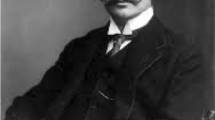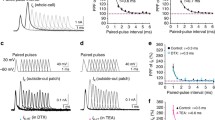Abstract
Vladimir Skok and his colleagues did much of the pioneering work on fast excitatory synaptic transmission in sympathetic ganglia and on nicotinic acetylcholine receptors that mediate fast transmission. I and my colleagues (including Alex Selyanko, one of Vladimir’s protégés) have studied the additional process of slow synaptic excitation that is mediated by the action of acetylcholine on muscarinic receptors. This results primarily from the closure of “M-channels,” a subset of voltage-gated potassium channels composed of Kv7.2 and Kv7.3 channel subunits. These channels require membrane phosphatidylinositol-4,5-bisphosphate (PIP2) for their opening, and their closure by muscarinic receptor activation is now thought to result from the reduction in PIP2 levels that follows receptor-induced PIP2 hydrolysis. The dynamics of these two forms of synaptic excitation are compared.
Similar content being viewed by others
References
V. N. Mirgorodsky and V. I. Skok, “Intracellular potentials recorded from a tonically active mammalian sympathetic ganglion,” Brain Res., 15, 570–572 (1969).
V. I. Skok and A. Y. Ivanov, “What is the ongoing activity of sympathetic neurons?” J. Auton. Nerv. Syst., 7, 263–270 (1983).
A. A. Selyanko, V. A. Derkach, and V. I. Skok, “Fast excitatory postsynaptic currents in voltage-clamped mammalian sympathetic ganglion neurons,” J. Auton. Nerv. Syst., 1, 127–137 (1979).
V. A. Derkach, A. A. Selyanko, and V. I. Skok, “Acetylcholine-induced current fluctuations and fast excitatory post-synaptic currents in rabbit sympathetic neurons,” J. Physiol., 336, 511–526 (1983).
V. A. Derkach, R. A. North, A. A. Selyanko, and V. I. Skok, “Single channels activated by acetylcholine in rat superior cervical ganglion.” J. Physiol., 388, 141–151 (1987).
A. A. Selyanko, V. A. Derkach, and V. I. Skok, “Voltage-dependent actions of short-chain polymethylene bistrimethylammonium compounds on sympathetic ganglion neurons,” J. Auton. Nerv. Syst., 6, 13–21 (1982).
V. I. Skok, A. A. Selyanko, and V. A. Derkach, “Channel-blocking activity is a possible mechanism for a selective ganglionic blockade,” Pflügers Arch., 398, 169–171 (1983).
M. V. Skok, L. P. Voitenko, S. V. Voitenko, et al., “Alpha subunit composition of nicotinic acetylcholine receptors in the rat autonomic ganglia neurons as determined with subunit-specific anti-alpha(181-192) peptide antibodies,” Neuroscience, 93, 1427–1436 (1999).
H. E. Purnyn, O. V. Rikhalsky, M. V. Skok, and V. I. Skok, “Functional nicotinic acetylcholine receptors in the neurons of rat intracardiac ganglia,” Fiziol. Zh., 50, No. 4, 79–84 (2004).
N. V. Marrion, T. G. Smart, S. J. Marsh, and D. A. Brown, “Muscarinic suppression of the M-current in the rat sympathetic ganglion is mediated by receptors of the M1-subtype,” Br. J. Pharmacol., 98, 557–573 (1989).
F. F. Weight and J. Votava, “Slow synaptic excitation in sympathetic ganglion cells: evidence for synaptic inactivation of potassium conductance,” Science, 170, 755–758 (1970).
D. A. Brown and P. R. Adams, “Muscarinic suppression of a novel voltage-sensitive K+-current in a vertebrate neuron,” Nature, 283, 673–676 (1980).
H. S. Wang and D. McKinnon, “Potassium currents in rat prevertebral and paravertebral sympathetic neurons,” J. Physiol., 485, 319–337 (1995).
T. J. Jentsch, “Neuronal KCNQ potassium channels: physiology and role in disease,” Nat. Rev. Neurosci., 1, 21–30 (2000).
H. S. Wang, Z. Pan, W. Shi, et al., “KCNQ2 and KCNQ3 potassium channel subunits: molecular correlates of the M-channel,” Science, 282, 1890–1893 (1998).
J. K. Hadley, G. M. Passmore, L. Tatulian, et al., “Stoichiometry of expressed KCNQ2/KCNQ3 channels and subunit composition of native ganglionic M-channels deduced from block by tetraethylammonium (TEA),” J. Neurosci., 23, 5012–5019 (2003).
A. A. Selyanko, J. K. Hadley, I. C. Wood, et al., “Inhibition of KCNQ1-4 potassium channels expressed in mammalian cells via M1_muscarinic acetylcholine receptors,” J. Physiol., 522, 349–355 (2000).
A. A. Selyanko, C. E. Stansfeld, and D. A. Brown, “Closure of potassium M-channels by muscarinic acetylcholine-receptor stimulants requires a diffusible messenger,” Proc. Roy. Soc., London, Ser B. 250, 119–125 (1992).
J. E. Haley, F. C. Abogadie, P. Delmas, et al., “The alpha subunit of Gq contributes to muscarinic inhibition of the M-type potassium current in sympathetic neurons,” J. Neurosci., 18, 4521–4531 (1998).
B. C. Suh and B. Hille, “Regulation of ion channels by phosphatidylinositol 4,5-bisphosphate,” Curr. Opin. Neurobiol., 15, 370–378 (2005).
B. C. Suh and B. Hille, “Regulation of KCNQ channels by manipulation of phosphoinositides,” J. Physiol., 528, 911–916 (2007).
P. Delmas and D. A. Brown, “Pathways modulating neural KCNQ/M (Kv7) potassium channels,” Nat. Rev. Neurosci., 6, 850–62 (2005).
D. A. Brown, S. A. Hughes, S. J. Marsh, and A. Tinker, “Regulation of M (Kv7.2/7.3) channels in neurons by PIP2 and products of PIP2_hydrolysis: significance for receptor-mediated inhibition,” J. Physiol., 582, 917–925 (2007).
N. Gamper and M. S. Shapiro, “Target-specific PIP2 signalling: how might it work?” J. Physiol., 582, 967–975 (2007).
J. S. Winks, S. Hughes, A. K. Filippov, et al., “Relationship between membrane phosphatidylinositol-4,5-bisphosphate and receptor-mediated inhibition of native neuronal M channels,” J. Neurosci., 25, 3400–3413 (2005).
S. Hughes, S. J. Marsh, A. Tinker, and D. A. Brown, “PIP(2)-dependent inhibition of M-type (Kv7.2/7.3) potassium channels: direct on-line assessment of PIP(2) depletion by Gq-coupled receptors in single living neurons,” Pflügers Arch. Apr. 20 (2007) [Epub ahead of print].
B. C. Suh, L. F. Horowitz, W. Hirdes, et al., “Regulation of KCNQ2/KCNQ3 current by G protein cycling: the kinetics of receptor-mediated signaling by Gq,” J. Gen. Physiol., 123, 663–683 (2004).
D. A. Brown and A. A. Selyanko, “Membrane currents underlying the slow excitatory post-synaptic potential in the rat sympathetic ganglion,” J. Physiol., 365, 335–364 (1985).
D. A. Brown, A. A. Selyanko, J. K. Hadley, and L. Tatulian, “Some pharmacological properties of neural KCNQ channels,” Neurophysiology, 34, Nos. 2/3, 91–94 (2002).
D. A. Brown, N. J. Buckley, M. P. Caulfield, et al., “Coupling of muscarinic acetylcholine receptors to neural ion channels: closure of K+ channels,” in: Molecular Mechanisms of Muscarinic Acetylcholine Receptor Function, J. Wess (ed.), R. G. Landes Co., Austin, TX (1995), pp. 164–182.
Author information
Authors and Affiliations
Corresponding author
Additional information
Neirofiziologiya/Neurophysiology, Vol. 39, Nos. 4/5, pp. 284–289, July–October, 2007.
Rights and permissions
About this article
Cite this article
Brown, D.A. The Skok legacy and beyond: Molecular mechanisms of slow synaptic excitation in sympathetic ganglia. Neurophysiology 39, 243–247 (2007). https://doi.org/10.1007/s11062-007-0033-6
Issue Date:
DOI: https://doi.org/10.1007/s11062-007-0033-6




